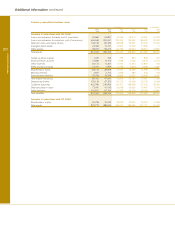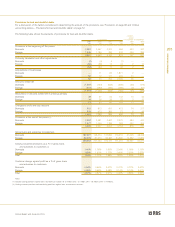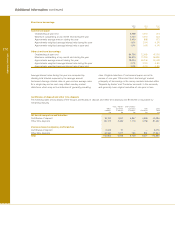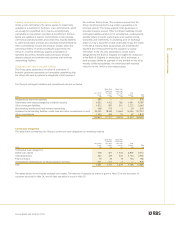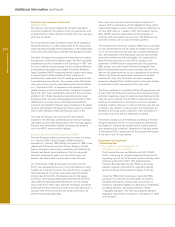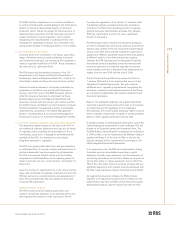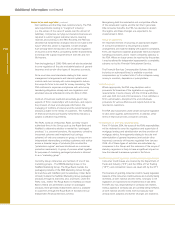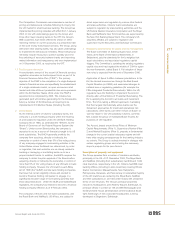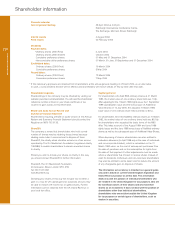RBS 2003 Annual Report Download - page 214
Download and view the complete annual report
Please find page 214 of the 2003 RBS annual report below. You can navigate through the pages in the report by either clicking on the pages listed below, or by using the keyword search tool below to find specific information within the annual report.
Additional information continued
212
Off balance sheet arrangements
The Group is involved with several types of off-balance sheet
arrangements, including special purpose vehicles, lending
commitments and financial guarantees.
Special purpose vehicles (“SPVs”)
SPVs are vehicles set up for a specific, limited purpose, do not
carry out a business or trade and typically have no employees.
They take a variety of legal forms – trusts, partnerships and
companies – and fulfil many different functions. They constitute
a key element of securitisation transactions in which an SPV
acquires financial assets funded by the issue of securities.
In the normal course of business, the Group arranges
securitisations to facilitate client transactions and undertakes
securitisations to sell financial assets or to obtain funding. It
has established a number of SPVs to act as commercial paper
conduits for customers. SPVs are also utilised in its fund
management activities to structure investment funds to which
the Group provides investment management services.
Under UK GAAP, the Group accounts for securitisations of
assets originated by the Group in accordance with FRS 5
‘Reporting the Substance of Transactions’. Assets are
derecognised and a gain or loss on disposal recognised if all
significant rights or access to benefits relating to those assets
and all significant risks in those benefits are transferred to
others. In cases where there is a significant change in the
entity’s rights to benefit and exposure to risk, the description or
monetary amount relating to an asset should be changed and
a liability recognised for any obligation to transfer benefits that
is assumed. Where a transaction in previously recognised
assets results in no significant change in the entity’s rights to
benefits in the assets or its exposure to risks inherent in those
benefits, the assets should continue to be recognised and no
gain or loss recognised. FRS 5 requires a linked presentation
where a transaction is in substance the financing of an asset
or pool of assets but where the item is financed in such a way
that the Group can suffer a loss which is limited to a fixed
monetary amount. The linked presentation involves showing the
gross amount of assets securitised less the related finance on
the face of the balance sheet – the net amount is included in
total assets. Profit is recognised on entering into the
arrangement only to the extent that non-returnable proceeds
exceed the previous carrying value of the assets securitised.
The Group securitises mortgage loans and other assets.
Under US GAAP, transfers of financial assets are accounted for
and reported based on the application of a financial-
components approach that focuses on control. Under this
approach, after a transfer of financial assets, the Group
recognises the assets it controls and the liabilities it has
incurred, derecognises financial assets when control has been
surrendered, and derecognises liabilities when extinguished.
Transfers of financial assets where the Group has surrendered
control over the transferred assets are accounted for as sales
and any gain or loss recognised in earnings. Otherwise,
transfers are accounted for as collateralised borrowings.
As financial intermediary, the Group arranges securitisations of
client assets. These include multi-seller commercial paper
conduits and client intermediation transactions. The Group has
established a number of SPVs to act as commercial paper
conduits. These allow customers to access liquidity in the
commercial paper market by selling assets to the conduit that
funds the purchase by issuing commercial paper to third
parties. The Group supplies certain services and contingent
liquidity support to some or all of these vehicles on an arm’s
length basis as well as programme credit enhancement. Other
client securitisations arranged by the Group involve individual
SPVs established to purchase customer assets financed by the
issue of debt obligations to third parties. The Group may act
as advisor to the manager of the SPV and provide liquidity
facilities to it.
Under UK GAAP the Group accounts for fees received from
client securitisations in line with its usual policy for similar fees
from other banking activities. Undrawn liquidity lines are
included within undrawn commitments in Note 41 on page 179;
any drawn amounts will be included in loans and advances.
The assets and liabilities of the SPVs are not recognised on the
Group’s balance sheet unless the SPV is a quasi-subsidiary of
the Group. A quasi-subsidiary is defined in FRS 5 as ‘a
company, trust, partnership or other vehicle, that, though not
fulfilling the definition of a subsidiary, is directly or indirectly
controlled by the reporting entity and gives rise to benefits for
that entity that are in substance no different from those that
would arise were the vehicle a subsidiary’.
Following the issue of FASB Interpretation (“FIN”) No. 46 (revised),
the Group has consolidated SPVs acting as commercial paper
conduits and involved in other asset-backed transactions in its
US GAAP disclosures. Applying FIN 46R has resulted in total
assets on a US GAAP basis increasing by £6.9 billion. Further
information on FIN 46R can be found in Note 53 on page 198.
Additional information


